The climbing beauty in your garden is the Rose Lagoon. Description, photo, care features
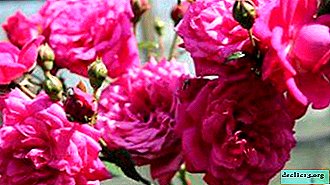
The climbing rose lagoon is a popular ornamental plant that actively decorates gardens and flower beds.
The reason for this success is a long flowering, which lasts 2 waves, as well as resistance to frost, so you can grow a flower in the northern regions.
In the article, we will examine clearly in the photo what this variety of roses looks like, and also learn how to properly care for them.
Description
The lagoon is one of the best landscape roses among climbing varieties. It grows rapidly, striving upward and perfectly creates living arches, columns, cascades. The plant is unpretentious in care, can be planted in the garden, on the terrace.
The lagoon is a very bright and juicy rose that blooms throughout the season, right up to the autumn frosts. The bush is tall and strong, its height is 2-2.5 m, and its width is 1 m.
The sheet plate is dense and glossy, dark green. The flowers are large and double, raspberry color.Photo
Below you will see a photo of the flower:
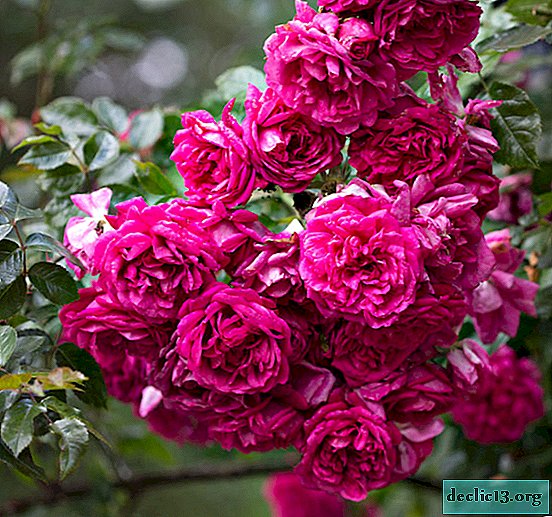
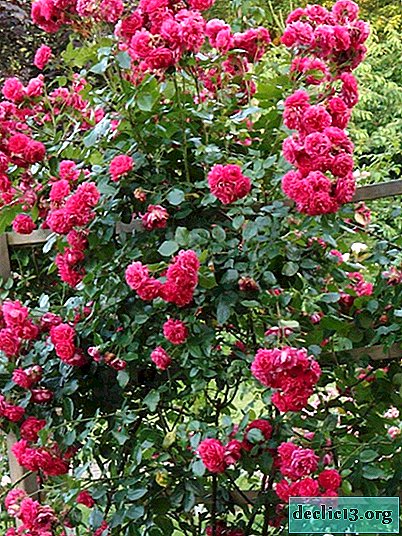


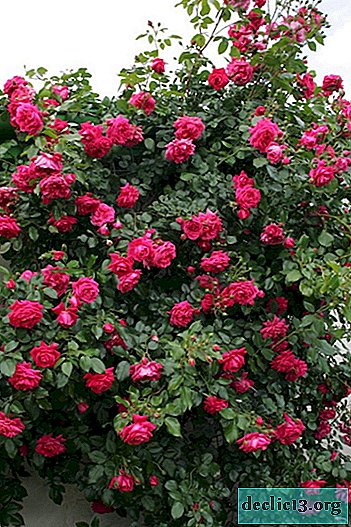
History of occurrence
The development of the Lagoon rose was carried out by the German company Wilhelm Cordes and Sons. In the process, the company employees wanted to get a rose that would be hardy, resistant to disease, frost and weather.
What is the difference from the rest of the species?
The peculiarity of the variety is its unpretentiousness, resistance to frost and the main diseases of the rose.In addition, the flower was awarded the following awards:
- gold and silver medals of the ADR rose contest Baden-Baden (Germany), 2007;
- gold medal of the rose contest Geneva (Switzerland), 2007.
Bloom
When and how?
Long flowering makes the Laguna variety the most popular. In early summer, a lot of velvety raspberry buds appear on the bush. They are large, as their diameter is 10 cm. The bud is formed of 50 petals. Flowers grow with magnificent brushes of 5-10 pieces. In addition, they emit an incredibly pleasant spicy-fruity aroma that spreads throughout the garden.
Care before and after flowering
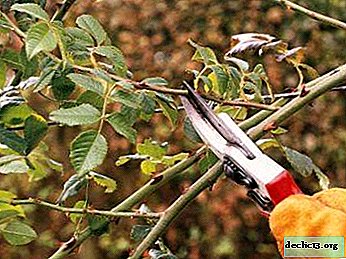 Care Features:
Care Features:
- In spring, pruning is necessary to stimulate the growth and bloom of the rose. All unhealthy, weak branches are removed to the pruning process.
- At the stage of bud formation, abundant watering and feeding with potassium and phosphorus are important.
- After flowering, faded buds are removed, watering is reduced, and fertilizer is stopped, preparing the plant for winter.
What if the buds do not appear?
If the Lagoon does not bloom, then the following reasons can affect this:
- Diseases The most dangerous are cancer and powdery mildew. This can be prevented if the plant is regularly treated with a 1% solution of Bordeaux fluid.
- Improper preparation for the winter. Before the onset of cold weather, it is necessary to provide a climbing rose with quality shelter.
- The high content of nitrogen fertilizers in the soil.
- Wrong place for landing.
- Illiterate pruning.
Step-by-step care instructions
Seat selection
The lagoon prefers to grow in a well-lit place. For her, drafts and near groundwater are unacceptable. It is best to choose a plot with a slight slope. In such a place there will definitely not be stagnation of rainwater.
What should be the soil?
The lagoon prefers to grow in light, nutritious, air- and moisture-transmitting land. You can make a nutritional composition with your own hands if you mix the following components:
- fertile garden soil - 10 kg;
- sand - 10 kg;
- peat - 5 kg;
- wood ash - 400 g;
- universal mineral fertilizer - 400 g.
Landing
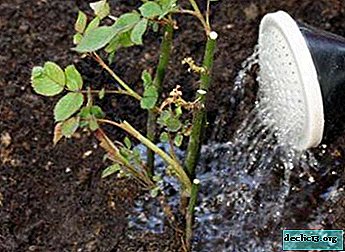 The correct landing of the Lagoon is as follows:
The correct landing of the Lagoon is as follows:
- Pre-pour the prepared substrate. Wait until the liquid is completely absorbed.
- Set the bush in the recess and position the roots around the entire perimeter of the bottom.
- Sprinkle the seedling with soil so that it does not cover the lower buds and a part of the root that smoothly passes into the trunk is visible.
- Trim the bush to 20-24 cm above ground level.
- About a young plant to establish a support in advance. It can be: a frame, a decorative staircase.
Temperature
The optimum temperature regime for climbing roses lagoon remains 23-25 degrees. Cover it for the winter will be required at a temperature of -5 degrees.
Watering
In the first year after planting, it must be watered every 4-5 days. Then the bushes are irrigated once every 9-10 days in the absence of rainfall. And although the Lagoon is not afraid of drought, because it has powerful roots that go deep into the earth, it is not worth waiting for the soil to dry completely. It is best to water in the evening or early in the morning, using settled water.
Top dressing
If during planting the landing pit was fertilized with organic matter, then in the future only mineral compounds will be added. At the beginning of the growing season, nitrogen fertilizers are used, in the middle - phosphorus and potash, and at the end - potash. Organics make only once every 2 years.
Pruning
Depending on the season, pruning is performed.
In the fall:
 Sanitary pruning is carried out, as a result of which it is necessary to remove all damaged parts of the plant.
Sanitary pruning is carried out, as a result of which it is necessary to remove all damaged parts of the plant.- Shorten the shoots by 1/3 of the length for shelter for the winter.
- Remove branches that are already 3 years old, since blooming is reduced because of them.
In the spring:
- It is necessary to remove the non-overwintered parts and tops of the shoots in order to prevent large growth and branching.
- On the arrows that grow sideways, you need to leave 2-3 buds.
- The formation of a bush involves the removal of excess and inaccurate growths.
How to tie a plant?
The process of tying a climbing rose can be performed in several ways:
- In order for the stems to freely extend up and to the sides, they will have to be fan-shaped, leaving the side shoots not tied.
- In order for the new side branches to create a flowering cloud, it is necessary to arrange the main shoots horizontally, tying them to a support.
- To whip around the pillar or arch, the shoots must be directed around the support and tied in a spiral.
Transfer
When the earth thaws from winter frosts, and buds have not yet formed on the branches of roses, you can proceed to the transplant:
- Carefully remove the aerial part of the bush from the support, and dig the plant itself, retreating from the base by 50-60 cm.
- Extract the plant from the soil, clean the roots from the ground.
- Prepare a new pit, the dimensions of which coincide with the dimensions of the measles system.
- Lay a layer of expanded clay on the bottom, and then a layer of nutrient soil.
- Plant a plant, direct the roots down and fill up the hole, slightly tamping the soil.
Preparation for winter
For the Laguna rose, shelter for the winter is a mandatory procedure. They bend the branches under the shelter before the frosts, since to do this in frosts simply will not work without damage. A spruce tree is laid between the wattle and ground to prevent the shoots from touching the ground.
How to propagate?
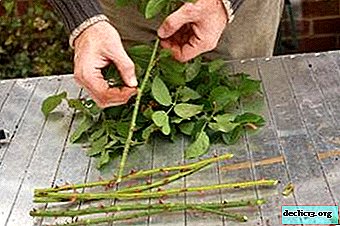 The rose lagoon propagates in two ways - by seeds and seedlings. But most often flower growers practice the second method, adhering to the following recommendations:
The rose lagoon propagates in two ways - by seeds and seedlings. But most often flower growers practice the second method, adhering to the following recommendations:
- To cut the cuttings, it is necessary to use already faded branches.
- There should be 2 internodes on the cut fragment, and the cut site, made at an angle of 45 degrees, should be located close under the kidney.
- The upper section is performed at a distance from the kidney.
- At the cutting, all the lower leaves are cut, and the upper ones are only half.
- A shank is placed in the prepared container with sand and soil, deepening it by 1-2 cm, covered with a glass jar on top and cleaned in a well-lit place.
- From time to time, the stalk is watered, do not allow the penetration of direct sunlight.
Diseases and Pests
Rosa Laguna resists black spotting and powdery mildew. But there are several pests that are dangerous for the flower:
- Spider mite. Small arachnid insects that take a yellow color. They form on the inside of the leaf where they leave a web. After their activity, the leaves turn yellow, dry and fall away. To combat use systemic insecticides.
- Aphid. It affects leaves, stems and buds, sucking juice. For the fight, drugs are used: Actellik, Aktara, Fufanon. Processing is carried out every 3 days.
Rosa Laguna is a beautiful and fragrant plant that does not have special care requirements and can endure weather conditions. Regular watering, fertilizing and pruning will allow the bush to bloom for a long time and plentifully.

 Sanitary pruning is carried out, as a result of which it is necessary to remove all damaged parts of the plant.
Sanitary pruning is carried out, as a result of which it is necessary to remove all damaged parts of the plant.















